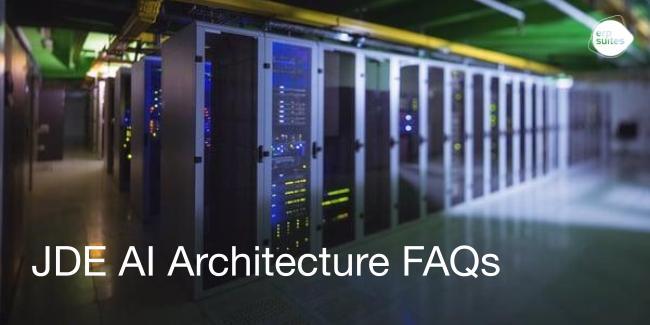Troubleshooting 7 Common Issues in Managed Services
December 20th, 2023
4 min read
.png?width=960&height=540&name=Blog%20Images%20(5).png)
Managed services within ERP Suites, especially in the realm of JD Edwards (JDE), encompass a multifaceted department that spans CNC, system operations, data infrastructure, and more. This comprehensive support system caters to a spectrum of client needs, from basic JDE support to fully managing the entire operating system.
In this blog, we'll delve into the intricacies of managed services, shedding light on common issues faced by both providers and clients.
Selecting Your Managed Services
The decision to opt for a fully managed service or a more tailored approach often hinges on the client's internal capabilities and preferences. While some choose a fully managed service for the ease it provides in handling everything from environment setup to user access and data backups, others may prefer a more specialized support plan, maintaining their own IT teams alongside CNC-managed services.
At ERP Suites, a significant majority of managed customers fall under the fully managed category, where the system operations team oversees active directory, operating systems, patching, and security updates.
Routine Issues
Recurrent challenges in managed services primarily revolve around user management, storage issues, lack of planning and hardware assessment. Determining a solution first necessitates determining where exactly the issue lies.
-
User Management
Common user management scenarios include troubleshooting user interactions, creating new user profiles, and ensuring proper access to files. Another routine matter is software updates, where clients seek compatibility assessments and seamless execution to avoid disruptions.
Scripts, often written during CNC operations, pose another challenge. Take, for example, custom scripts for repetitive tasks, that need to be performed in a concise order. They are crucial for system operations and may be forgotten until a tech refresh is due, requiring meticulous review and documentation. Unraveling these forgotten scripts during tech refresh can trigger a cascade of errors, delays, and costly rework.
This issue could also be related to service scripts. These offer custom actions such as synchronizing files and users or providing a logical flowchart for automation. Scripts are interpreted by the OS to automate any action imaginable within the OS. Without documentation, this can lead to additional time spent discovering where and what they are.
-
Storage Woes
A prevalent issue stems from inadequate planning regarding storage size for your JD Edwards environment. This encompasses your servers, virtual machines, fat clients, web servers, and various software. Clients, uncertain about their actual needs, tend to err on the side of excess, leading to requests for later downsizing.
Migrating data to new storage tiers or platforms carries a heavy price: time, resources, downtime, and potential operational disruptions. Smoothly transitioning applications to the new configuration requires meticulous testing and likely configuration tweaks. Furthermore, reconfiguring backup and recovery processes is essential to maintain data protection in the new environment. This significant downtime and extra work emphasizes the importance of accurate initial assessments.
-
Proper Planning
To prevent such issues, engaging the system operations team in a thorough discussion about department requirements and software needs is vital. Properly interpreting vendor requirements and tailoring storage configurations to the environment can save significant resources in the long run. There may need to be an emphasis on matching those requirements by the vendor to the customer. Choose vendors with expertise in your specific JD Edwards environment and preferred storage solutions. This ensures seamless integration and avoids compatibility headaches. -
Virtual Machine Setup and Configuration
In virtual machine setups, storage concerns extend beyond size to configuration. Improper configurations, such as too many hard drives sharing a single controller, can lead to performance bottlenecks, especially in data-intensive operations like databases. -
Hardware and Vendor Requirements
Assessing the hardware and networking requirements, including the choice between magnetic and solid-state drives, is crucial in avoiding future issues.
A common pitfall is neglecting to thoroughly assess vendor requirements and building the virtual machine before understanding the implications. Rushing through the setup process and attempting to trim excess afterward often results in extended downtime. Taking the time to plan and prepare is essential—a mantra reminiscent of "measure twice, cut once."
When setting up the environment, understanding the nature of the software and its intended usage is paramount. Distinguishing between user-centric and service-centric environments dictates hardware and networking requirements, security protocols, and monitoring needs. Factors such as data backup and recovery, user education, and integration with LDAP (Lightweight Directory Access Protocol) also play pivotal roles.
-
Legacy Items and Active Directory
Legacy items, exacerbated by Microsoft's domain hardening initiatives, pose a unique set of challenges. Outdated software relying on deprecated encryption methods like DES (Data Encryption Standard) becomes obsolete, requiring updates or replacements to align with modern active directory environments.
People have gotten away with legacy software for some time, and Microsoft has supported it in roundabout ways. With the increase in malicious ransomware attacks, as well as Apple and Linux competing and offering “security” as an advantage, Microsoft has had to remove much of its legacy support to close these security flaws. This may come as a surprise, as some long-standing, multi-decade software environments may no longer be as easily accessible as they once were.
While LDAP integration streamlines user management, implementing unsecured LDAP can expose vulnerabilities. Encouraging clients to use LDAPS ensures encrypted data transmission, safeguarding sensitive information. User education emerges as a key strategy in preventing issues like ransomware, emphasizing the importance of IT administrators controlling and educating users about potential threats.
-
Backup and Recovery Strategies
The often-overlooked aspect of backup and recovery strategies can lead to unforeseen complications. Recognizing the various backup types, such as versioning, full backups, and incremental backups, and tailoring them to specific needs is crucial. User errors, like accidental file deletions, underscore the necessity of a comprehensive backup strategy.
An expansion on Disaster Recovery and testing of your DR plans may be essential, as well. Many customers run backups, but fail to test them – and when a true disaster arrives, they find those backups to be useless.
Managed Services Success
Navigating the complexities of managed services in JDE/ERP requires a holistic approach, addressing routine issues, storage challenges, legacy items, and user-related concerns. By prioritizing thorough planning, proactive education, and strategic backup and recovery solutions, businesses can ensure a smoother and more resilient ERP environment. As the landscape evolves, embracing a mindset of continuous improvement and adaptation remains key to a successful managed services journey.
ERP Suites can help. For managed services that include functional and technical expertise, and a proven methodology in the process, reach out to us today.
Leyla Shokoohe is an award-winning journalist with over a decade of experience, specializing in workplace and journalistic storytelling and marketing. As content manager at ERP Suites, she writes articles that help customers understand every step of their individual ERP journey.
Topics:



.png?width=650&height=325&name=Blog%20Images%202_1%20(4).png)
.png?width=650&height=325&name=Blog%20Images%202_1%20(5).png)
.png?width=650&height=325&name=Blog%20Images%202_1%20(3).png)
.png?width=650&height=325&name=Blog%20Images%202_1%20(2).png)
.png?width=650&height=325&name=Blog%20Images%202_1%20(1).png)
.png?width=960&height=540&name=Blog%20Images%20(96).png)

.png?width=960&height=540&name=Blog%20Images%20(90).png)
.png?width=960&height=540&name=Blog%20Images%20(88).png)
.png?width=960&height=540&name=Blog%20Images%20(87).png)
.png?width=960&height=540&name=Blog%20Images%20(86).png)
.png?width=960&height=540&name=Blog%20Images%20(85).png)
.png?width=960&height=540&name=Blog%20Images%20(83).png)
.png?width=960&height=540&name=Blog%20Images%20(82).png)
.png?width=960&height=540&name=Blog%20Images%20(80).png)